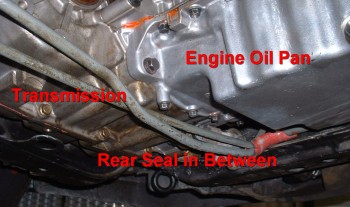Reader Question
My rear main seal is leaking, and it is very expensive to replace. Why is this so expensive and where is the rear seal located anyway?
Thank you,
Shannon
Dear Shannon,
I get this question a lot in my shop, “what exactly is the rear main seal and why is it so expensive to replace?”
Well I just happen to have some pictures of a rear seal replacement that we did in my shop that might help shed some light on why it costs so much to replace.
A rear main bearing seal, or rear seal as it is commonly referred to, is a big, round rubber seal between the engine and transmission.

Picture of rear main seal. The crankshaft (the internal engine part that the pistons are connected to) sticks out of the rear of the engine, and the flywheel and transmission bolt to this crankshaft. In layman terms, the crankshaft is what powers and turns the transmission.
The engine oil obviously is inside the engine and is lubricating the crankshaft, pistons and other internal parts of the engine. The rear seal fits snuggly around the rear of the crankshaft and keeps the engine oil from escaping.
When this rear seal leaks either the engine or the transmission has to be removed to gain access. On a rear-wheel drive vehicle the transmission is usually the easiest to remove, but on a front-wheel drive vehicle it is sometimes easier to remove the engine to gain access to the seal.
Here are some great pictures taken at my shop of the removal of a Volvo front-wheel drive engine to replace the rear main oil seal. Click Here for Pictures. We found an easier (if there is such a thing) way to remove the engine than the old method of removing the hood and hoisting out the engine from the top.
We drive the car on the lift, remove all engine mounting bolts from the body of the car, remove the radiator, suck out the Freon from the air conditioning system, and raise the car body with the lift. The outcome is an engine that is on jack stands on the floor which is much easier to work on than on an engine hoist.
What causes the rear seal to leak?
Running the engine low on oil can cause the rear main seal to become dry, and a crack or tear in the rubber can occur. This should be another good reason to change your engine oil regularly and use a good quality oil.
The crankshaft can also become out-of-balance due to an internal engine problem, and wear or “ride” on the lip of the seal in an asymmetrical pattern. The seal can also leak due to old age, or from an extended vehicle storage period that allows the seal to dry out and crack.
What else can be done to stop a leaking rear seal other than replacement?
Not a whole bunch. There are special oil additives on the market that are designed to swell the rubber of the rear seal and cause it to expand, thus sealing off the leak. You can also try using thicker weight engine oil, like 50 weight.
The thicker oil can fill in the gap between the seal and the crankshaft, and could
slow the leak down. Unfortunately, the only real cure is to replace the seal itself.
Blessings,
Austin Davis
